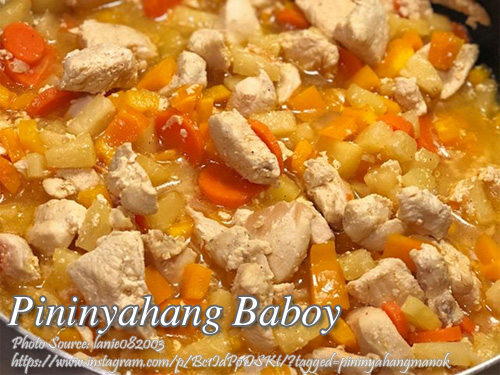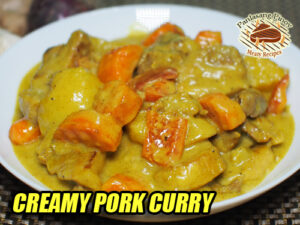This dish is the pork version of pininyahang manok. Where the meat is cooked in pineapple juice, coconut milk and pineapple chunks. The chicken version is the popular one and is one of the most favorite chicken dishes among Pinoys. The recipe here is the pork version which is not as popular as the chicken but it is as tasty and appetizing.
The ingredients are basically the same like the potatoes, carrots, bell peppers, pineapples and coconut milk except the chicken of course which is replaced by pork. Pork belly is the preferred part when cooking this dish but you can opt a leaner part like the pork tenderloin, pork butt or pork shoulder.
Pininyahang Baboy: Discovering a New Family Favorite
I’ll never forget the first time I tasted the pork dish. It was one of those lazy Sundays at my Tita Lydia’s house in Cavite, where we’d always gather as a family. She was known in our family for her incredible cooking—her dishes always had this special touch that made them unique. I remember she had just returned from a trip to Bicol, where coconut milk, or gata, is often used in savory dishes. Inspired by her travels and our family’s love for pork, she decided to tweak the classic pininyahang manok and make it with pork instead.
While pininyahang manok is undeniably a favorite among Filipinos, this pork version quickly became a hit in our household. The tender pork belly, simmered slowly in sweet pineapple juice and rich coconut milk, was so hearty and satisfying that even my cousins, who usually preferred chicken, were impressed.
A Twist on a Classic Dish
Pininyahang baboy might not be as famous as its chicken counterpart, but it carries the same delicious flavors, with a slight twist. The natural sweetness of pineapple paired with the creaminess of coconut milk perfectly complements the richness of pork. In fact, pork belly, with its layers of fat, absorbs the flavors wonderfully, making every bite indulgent. Tita Lydia told me that while pork belly is often her go-to cut for this dish, sometimes she opts for pork shoulder when she’s craving something a bit leaner.
The recipe is very similar to the chicken version, using familiar ingredients like carrots, potatoes, and bell peppers, but replacing the chicken with pork. The pineapple not only adds a tangy sweetness but also tenderizes the pork as it marinates. This is why it’s important to let the pork sit in the pineapple juice for at least 30 minutes before cooking. It ensures the meat turns out tender and flavorful, without being tough. I tried skipping this step once, thinking it wouldn’t make much of a difference, and I immediately regretted it—the pork wasn’t as tender or flavorful. It’s a small step but trust me, it makes all the difference!
Cooking Techniques: Why They Work
When preparing this dish, the key technique is browning the pork before simmering it in the sauce. My uncle Joey, who loves experimenting with food, once explained to me why this is essential. Searing the pork on high heat creates a crust that locks in the juices, which is crucial when cooking a fatty cut like pork belly. This also adds a depth of flavor that can’t be achieved if you skip this step. You only need to sear the pork for a few minutes until it’s lightly browned on all sides. Afterward, the pork is set aside while you build the rest of the dish’s flavors by sautéing garlic and onions.
Adding the bay leaves and peppercorns early in the process infuses the dish with a mild spiciness and a subtle, earthy aroma that balances the sweetness of the pineapple juice. This interplay of flavors—the sweet, savory, and slightly spicy—is what makes Pininyahang Baboy so special. Every spoonful is layered with taste, and when you pour that sauce over steamed rice, it’s simply irresistible.
A Touch of History
Did you know that the dish pininyahan—whether it’s made with pork or chicken—has its roots in Spanish colonial times? Pineapples were introduced to the Philippines by the Spanish, and Filipinos quickly adapted the fruit into their cooking. The dish’s use of both pineapple and coconut milk is a beautiful example of how Filipino cuisine melds influences from its colonizers with local ingredients. This blending of flavors—sweet, salty, and creamy—is quintessentially Filipino. Over the years, variations of pininyahan have sprung up across the archipelago, with some regions using chicken and others opting for pork or even seafood.
The Final Touch: Perfecting the Dish
Once the pork has simmered long enough to become tender, the final steps come together quickly. Adding the vegetables—potatoes and carrots—toward the end of the cooking process keeps them from becoming too mushy, while the bell peppers and chilies give the dish a slight crunch and vibrant color. I remember my cousin Isabel adding red chilies for a bit of heat, a trick she picked up from her mother-in-law, who hails from Bicol. That subtle kick cuts through the richness of the coconut milk, making each bite more exciting.
Finally, the addition of pineapple chunks at the end is like a sweet, refreshing surprise that ties all the flavors together. I love how the pineapple enhances the pork’s natural flavors while balancing the richness of the coconut milk. My brother Paulo, who is quite the picky eater, always reaches for extra pineapple when we have this dish—it’s his favorite part!
A Dish to Bring Families Together
Every time I make pininyahang baboy, it feels like a small celebration. The dish reminds me of those family gatherings at Tita Lydia’s house, where we’d spend hours around the table, savoring each bite and sharing stories. For me, this dish isn’t just about the delicious combination of pork, pineapple, and coconut milk; it’s about family, tradition, and the memories we make in the kitchen and around the dining table.
So, if you’re looking to switch up your usual pork recipes, or if you’ve already tried pininyahang manok and want to explore a different version, give this pork pineapple stew a try. You might find that it’s just as comforting and delicious—maybe even more so—than the original. And who knows, it might become a new favorite in your family too.
How to Cook Pininyahang Baboy
Ingredients
- 1 kilo pork belly or pork shoulder slice into cubes
- 3 pieces potatoes peeled, quartered
- 1 large can canned coconut cream
- 1 small can pineapple chunks reserved syrup for marinate
- 1 cup pineapple juice
- 1 pc medium size carrot peeled, cut into wedges
- 1 pc medium size red or green bell pepper cut into strips
- 1 pc large bird's eye chili chopped
- 2 pcs bay leaves laurel leaves
- 3 cloves garlic minced
- 2 pcs red onions chopped
- 1 tsp. peppercorns crushed
- 2 tsp. patis fish sauce
- 2 tsp. brown sugar
- salt to taste
- cooking oil
Instructions
How to cook Pininyahang Baboy:
- In a large bowl, put the pork and season with salt. Pour in the pineapple syrup and marinate the meat for at least 30 minutes. Drain and set aside.
- Heat about a tablespoon of oil in a large wok and saute the pork for 2 to 3 minutes until all sides are slightly brown. Drain from oil and set aside.
- In the same wok, saute garlic and onions until the onions are soft. Add in the pork, peppercorn, bay leaves and fish sauce and saute for about 3 minutes.
- Add in the water, pineapple juice and sugar. Bring to a boil and simmer until the pork is tender stirring occasionally. Add water if necessary.
- Then pour in the coconut cream and stir. Add in the potatoes and simmer 2 minutes stirring constantly.
- Next is add the carrots and simmer for another 3 minutes until the carrots and potatoes are cooked and the sauce is thick. Season with salt and pepper as needed.
- Last but not the least is add the pineapple chunks, bell peppers and red chilies. Cover and cook for another minute and turn off heat. Serve with steamed rice and enjoy!
Notes
Cooking Tips:
Marinate the Pork for Maximum Flavor
Let the pork marinate in pineapple juice for at least 30 minutes before cooking. The acidity in the juice helps tenderize the meat while infusing it with a subtle sweetness. Skipping this step can result in tougher, less flavorful pork.Sear the Pork for Better Texture
Brown the pork on all sides before simmering it in the sauce. This searing process locks in the pork’s juices and creates a flavorful crust that enhances the overall texture. It also adds a depth of flavor to the dish that complements the sweet and creamy sauce.Add Vegetables at the Right Time
To keep the vegetables from becoming too soft or mushy, add them in stages. Potatoes should be added first since they take longer to cook, followed by carrots, and finally, bell peppers and chilies. This ensures the vegetables retain their texture and vibrant color, balancing the dish perfectly.





